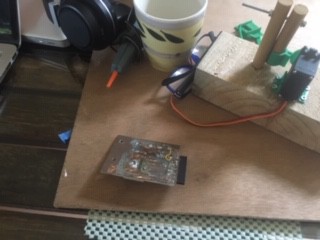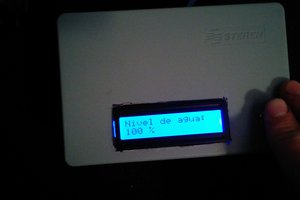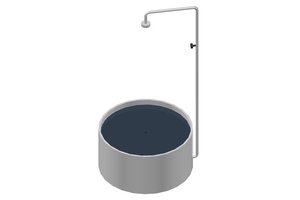Iteration 1.
I used a clear pipe vinyl vertical tube on the pump outtake to show water level. The tube was about 12mm in diameter and the water level was fairly easy to see. The pressures varied considerably when the pump was on which was when I was most interested in the reading. The clear vinyl tuning clogged up with algae over time and the connection to main out take pipe was mildly complicated.
Iteration 2.
I used two BMP180 breakout boards. One I encased in a 3d printed box. It was connected to a water hose by coiled tubing to reduce water contamination. The breakouts communicated by I2C and there was a clash of addresses, so got separate readings by switching between them using an an analogue switch.
The prototype worked to the point where I could measure water level to a about 1-2cm but making a reliable assembly seem difficult. The issue of an independent power supply was not addressed in the prototype.
The Water connection was via some coiled tubing on the back, which has since broken off in the junk box.

Iteration 3.
The clear vinyl tubing in the first iteration worked but I wanted something that had a separate connection to the tank and would not clog with algae.
I had a roll of clear 4mm aquarium air tubing lying around so I decided to use that to set up a siphon. I fed the tube through the top of the tank to the bottom. The main hole in the top of the plastic tank was covered by mesh to prevent rubbish from getting in. I did not want to disrupt the mesh so I drilled an 8mm hole in the top of the tank. You need tubing at least as long as 3 times the height of the tank.
I had trouble setting up a siphon just by sucking on tube by mouth, so I back filled the tubing with water from a garden hose. That started the siphon satisfactorily. Raising the end of the tube to the level of the tank water stopped the siphon. I draped the tube over the top overflow pipe, above the highest water level and the water level stayed the same as the water level in the tank.
The water level was difficult to see in the thin tubing and it seemed likely that algae would quickly clog the narrow tubing.
I decided to inject about 7ml of Aperol with a 10ml syringe. The orange colour was clearly visible. The system has been in place for a couple of months now with no trace of algal growth .
Note: Aperol has a nice orange colour and seems to be sufficiently alcoholic to inhibit algae. Similar beverages like Cinzano or even a fortified red wine like Port should also work. Unfortunately stronger spirits like vodka or gin which would be expected to have a stronger anti-algal effect are often clear. A darker whisky may be sufficiently coloured to act as an indicator.
Safety Note.
Alcohol is potentially toxic so risk of alcohol contamination needs to be considered. The tank has a capacity of 3000l. If the entire 5ml Aperol injection was mixed into the main tank , when full, it considered that that there would be no significant risk of drinking even as much as a litre at this degree of dilution. More worrying is the risk of contamination if the tank was near empty. Even so there has been no recorded morbidity or mortality in the literature from consuming as much as 5m of pure Aperol diluted to 50%. Risk is further mitigated by the observation that there has been no apparent mixing of the Aperol in the tubing with water in the tank over a period of several months.
 sgall17a
sgall17a
 José Miguel Díaz
José Miguel Díaz 
 Anteneh Gashaw
Anteneh Gashaw
 MechaTweak
MechaTweak
I use a white, plastic, recycled 55 gal barrel that you can see the level from the outside through the wall. Then I put a non-contact ultrasonic sensor in the top connected to a NodeMCU to remotely read the level. https://sites.google.com/site/nodemcu12e/#h.ujohu4coegej